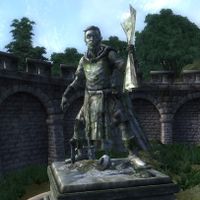This article is about the original epic. For the translation by Florin Jaliil, see Father Of The Niben.
The Udhendra Nibenu (Aldmeris for "Father of the Niben")[1] is an epic depicting Topal the Pilot's journey charting Tamriel and its waterways, as well as his many discoveries along the way. It remains the only written record of him and his ship; the Niben's voyages.[Note 1] All that is left, however, are four fragments, which detail moments across his travels, including his journey through the Niben River and his discovery of the Heartlands, where the Imperial City would eventually be build.[1]
HistoryEdit
The origins and nature of this text are unknown, as is the identity of its writer. Based on the fragments, it is a third-hand account of the journey from someone other than Topal or a Niben crewmate. It was penned sometime after their return to the Summerset Isles in the middle Merethic Era. It is considered some of Topal's lasting legacy left on Tamriel, along with his ancient maps held in the Crystal Tower. How it has survived over the eras and how it became fragmented are also unknown.[1]
In the late Third Era,[Note 1] the scholar Florin Jaliil decided to translate the Udhendra Nibenu's fragments in Tamrielic for the sake of "simple coherence". Not only does he provide his translation but gives his own interpretations of the text.[1] Through his translations, people were able to read it and vicariously live through Topal's journey. Some people have grown up on the stories.[2] Scholars have referenced it over the years, like in their treatises and observations of the Argonians.[3][4]
The FragmentsEdit
The first fragment mentions two of three ships that had left Firsthold to find the lost continent of Aldmeris, the third of which was Topal's ship, the Niben. It begins by referencing the second ship; the Pasquiniel helmed by Illio, whose waystone pointed south to where it is presumed to be Pyandonea. It further explains how the Niben was the only ship to return after "eighty moons", and with a wealth of goods and curiosities. After sixty-six days and nights, he reached the mouth of a great bay and landed on a "sun-kissed meadow of gentle dells" where he was attacked by Orcs.[1]
Considering that the second fragment is presumed to take place in eastern Morrowind on the Padomaic Ocean, the time difference is believed by Florin Jaliil to be eighty months. At this point, Topal is trying to find his way back to Firsthold when he could not find Aldmeris. The cliff coastline provided no westward passage for the Niben so they kept traveling south. They found harborage on a sandy, forested island but were attacked by a great "bat lizard" believed to be ancient cliff racers. Topal successfully brought it down with his bow and arrow, and for another forty days and nights, the Niben kept sailing south.[1]
The third fragment is set on the southern Black Marsh coast, where he witnessed the ancient Argonians and eventually discovered the Topal Bay. The fourth fragment tells the tale of how they sailed through the Niben River and witnessed "cat demons" that Florin Jaliil believed were ancient Khajiit. This fragment, in particular, is important because it is the only text that mentions the lost bird beastfolk of Cyrodiil. In the fragment, Topal provides them with the gift of literacy, and in exchange, they name him their lord and offer the eight islands as a gift. It ends with Topal's promise to return and the Niben's departure.[1]
The Pilot's Purchase was theorized by Amalien of the Antiquarian Circle of the University of Gwylim to be one of the unknown fragments of the Udhendra Nibenu. A fragment of the text was shared by Sister Chana Nirine of the Cult of the Ancestor Moth during her interview with the University in 2E 582. Since the interview, Amalien had sent multiple letters to Sister Nirine and her Order requesting clarification on the matter but had yet to receive a response.[5]
GalleryEdit
NotesEdit
See AlsoEdit
- For the book that translated it, see the Father Of The Niben.
ReferencesEdit
- ^ a b c d e f g Father Of The Niben — Florin Jaliil
- ^ Storbarda's dialogue in ESO: Greymoor
- ^ Wet Wilds of Black Marsh — Cirantille
- ^ Letter to Septimius — Junia Severa
- ^ Loremaster's Archive - Elder Scrolls & Moth Priests — Sister Chana Nirine
- ^ The Library of Dusk: Rare Books
- ^ Gandranen Ruins loading screen text in ESO
